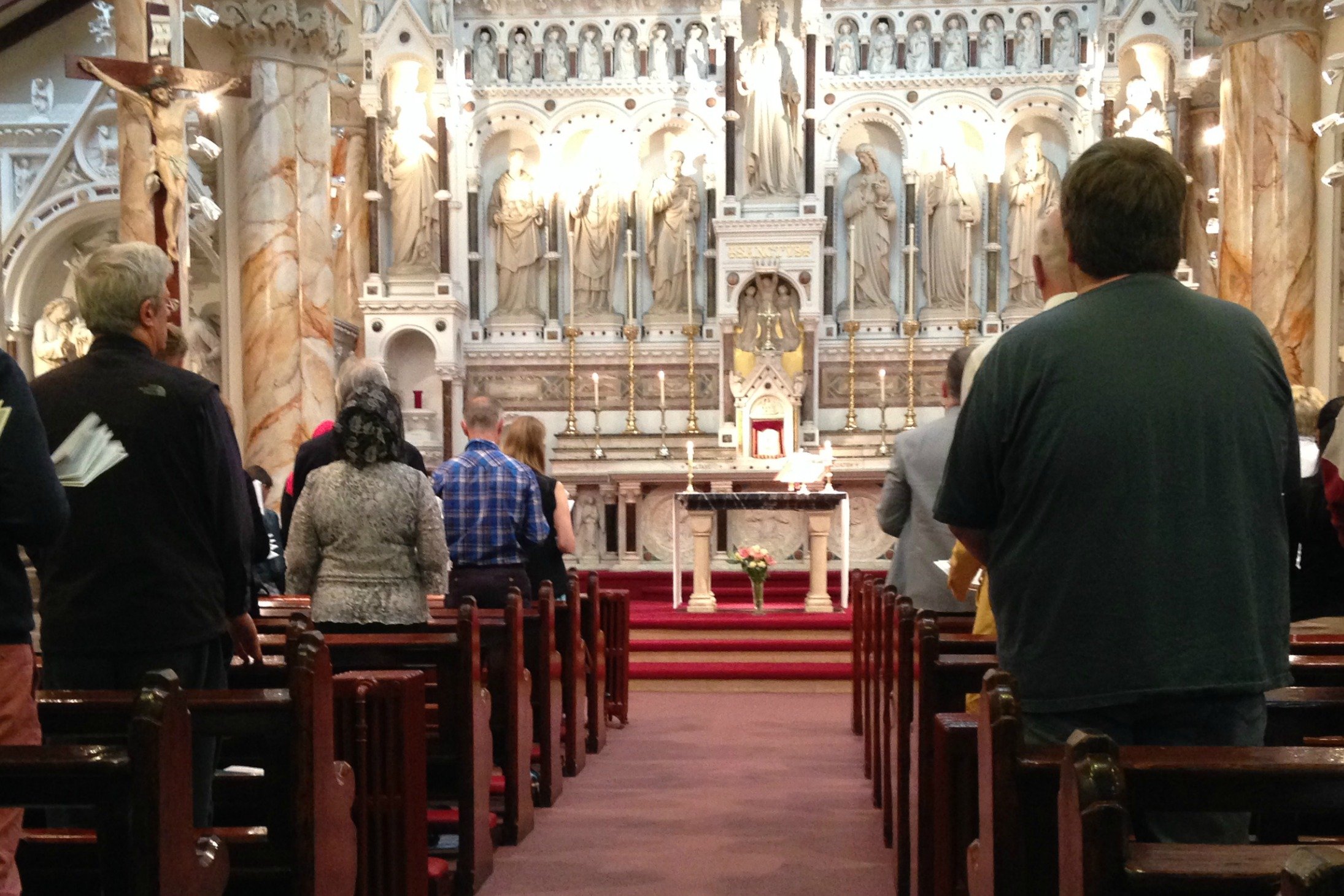Email is well suited for promoting un-meditated thinking. We say something. Hit send. And boom—it’s out there. We can’t selectively remember or reimagine what we said, as in a verbal conversation—there’s a record. But sometimes a slip of the keyboard can be revealing.
Catching up with a friend via email, I excitedly wrote:
I had the most amazing experience with Kid #2’s Baptism. Not to imply that Baptism itself isn’t awe-inspiring, but I might have seen liturgical evangelization happen before my very eyes. Family and friends came and attended Mass beforehand, and then the Baptism afterwards. Later at our house, people kept coming up to me and offering unsolicited comments, including:
“All my life I’ve been going to Mass. I’ve always felt like I’m just going through the motions, but this was something different. I’ve never experienced anything like it at Mass.”
“I haven’t felt that much joy at Mass in a long time.”
“I felt like I could be myself.”
“It was like I was praying during the Liturgy of the Word.”
“I never knew so much happens at Baptism. It was so involved!”
“I haven’t been that joyful at Mass since my wedding day.”
Why was I so struck by the unsolicited comments? Because these were typical modern-day Americans who would generally perceive “ritual” as rigid boredom and affective religious experience as exceptional and/or barely believable. Even more amazingly, a few weeks later, a few were still mentioning how much they remembered that Mass and Baptism—clearly it’d made a mark. I wondered as I summarized the event in my email correspondence, “Is this what liturgical evangelization looks and feels like?”
There it was, the term “liturgical evangelization”—again. I’d used it twice in a few paragraphs. But what did I mean? What is liturgical evangelization?
At first glance, liturgical evangelization seems to unite two actions of Christian faith that we often distinguish pastorally through job titles (i.e. Director of Evangelization and Director of Liturgy) or in competition for finite resources in a parish (i.e., “Are we going to spend this money on new hymnals or food for an outreach booth at the county fair?”). At a conference for pastoral musicians, one might encounter a talk on how to make liturgy more evangelizing—with the assumption that evangelization is an optional add-on to “real” liturgical matters. Likewise, a training conference for campus ministers might include daily Mass as formation, but reduce “liturgical evangelization” to choosing sacramental preparation materials.
I’ve been [willingly] indoctrinated enough by David Fagerberg to immediately suspect that viewing liturgy as something that may or may not be evangelization, and evangelization as something that may or may not include liturgy is too cursory for such dynamic, and essentially Holy Spirit-driven terms. In Theologia Prima: What Is Liturgical Theology? Fagerberg remarks, “although the phrase ‘liturgical theology’ contains two words, only one thing is being named.”[1] This claim resonates beyond mere semantic preferences because of his underlying premise, that liturgy does not “dilute theology”—but instead “liturgical theology [as one thing being named] dilates our understanding of both liturgy and theology.”[2] Might the same be true for liturgical evangelization?
Approaching “liturgical evangelization” as a unified term requires less creativity than our pastoral practices and/or organizational cultures might indicate. Consider the question, what happens in and through liturgy? The Paschal mystery “by which Christ accomplished the work of our salvation” is celebrated, proclaimed, accomplished, and continued “so that the faithful may live from it and bear witness to it in the world” (CCC §1066–1069). Bear witness to it in the world? Our understanding of evangelization has been stretched from the cursory sense of “getting more people to Mass” to an intended effect of liturgy. But that’s not all. The Church also teaches that evangelization is “to preach and teach, to be the channel of the gift of grace, to reconcile sinners with God, and to perpetuate Christ’s sacrifice in the Mass” (Evangelii Nuntiandi, §14). Our mental model has been stretched again—evangelization must be bigger, more encompassing than liturgy, even though evangelization is a consequence of liturgy. To say “liturgical evangelization” (or “evangelistic liturgy”) is redundant. Actions that are truly liturg-izing are a divine invitation for our participation in evangelization. All true evangelizing does liturgy.
Saying “liturgical evangelization” points to a foundational truth—both liturgy and evangelization can only be properly understood in the context of our experience of the overflowing love of the Trinity. As Pius XII wrote in Mediator Dei, liturgy is “the public worship which our Redeemer as Head of the Church renders to the Father, as well as the worship which the community of the faithful renders to its Founder, and through Him to the heavenly Father” (§20). Thus, to do liturgy is to be united through the Holy Spirit to Christ and the eternal love the Beloved Son offers to the Father. Evangelization is also essentially rooted in this same Trinitarian relationship. By evangelizing, the Church “imitates” the Trinitarian God, “who communicates himself through the gift of his Son to humanity, who lives in Trinitarian communion and who pours out the Holy Spirit so as to carry on a dialogue with humanity.”[3] This is not detached imitation—where a teacher demonstrates a process once and leaves—but participatory imitation, as the “preeminent and most active place of the Holy Spirit is in the Church’s evangelizing mission” (EN §75). In liturgy, we are joined to Christ and made worthy to offer divine worship in the Holy Spirit.[4] This is awe-inspiring and amazing. In evangelization, the Holy Spirit possesses, leads, and acts in every evangelizer, transforming us and enabling us “to enter into the perfect communion of the blessed Trinity.”[5] This is equally awe-inspiring and amazing. Liturgical evangelization broadens our wonder and amazement at the gifts of communion and sanctification offered not only at Mass, but also through our participation in the entire process of evangelization.[6]
Thus to do liturgical evangelization requires a relationship of Trinitarian communion that is on going. Every earthly end is always a renewed beginning. As the Second Vatican Council explained, “the liturgy is the summit toward which the activity of the Church is directed; at the same time it is the font from which all her power flows” (Sacrosanctum Concilium, §10). Celebrating the mystery that proclaims, continues, and accomplishes our salvation is the “summit” or goal because it achieves, “in the most efficacious possible way,” our sanctification in Christ and the glorification of God” (SC §10). But it is not an end, as the font births the power of “new life which comes from the Holy Spirit” (SC §6).[7] The Holy Spirit is both the principal agent and goal of evangelization (cf. EN §75). Like the summit that is also an overflowing font, the Holy Spirit is a goal but not an end, “carry[ing] on inwardly [Christ’s] saving work and prompt[ing] the Church to spread out” (Ad Gentes, §4). The liturgy renews the Church’s self-giving (cf. Evangelii Gaudium, §24). Liturgical evangelization expands our hearts to experience our vocation to spread the Gospel—not as a burdensome addition to our pastoral planning—but as participation in the precious font overflowing with the Holy Spirit that enables our entry into the perfect communion of the blessed Trinity, even away from Eucharistic summits.
Liturgical evangelization widens our perspective to see another essential summit. The “summit” of the “dynamism” of “evangelization”—the “clear proclamation that, in Jesus Christ, the Son of God made man, who died and rose from the dead, salvation is offered to all men, as a gift of God’s grace and mercy” (EN §27). This other summit does not exist to compete with the Eucharistic summit (that would be liturgy versus evangelization, instead of liturgical evangelization) (cf. EN §27). Discovering this other summit and choosing to respond freely by ascending in faith makes true participation in the liturgy possible.[8] Many pass by this other summit, assuming that it’s a ‘nice to know’ sort of thing—you know, for ‘real’ sinners—not those of us who are generally decent people by modern-day standards. But this is not the case. A hunger to seek and respond, to jump with joy because salvation has come to the person in need of redemption is a precondition for true participation in the liturgy.[9] From this summit of the offer of salvation, we see the Eucharistic summit more clearly—there is a reason to travel to and from the Eucharistic summit. Neither summit can be fully embraced by looking at it from a distance—both must be experienced. Liturgical evangelization ensures our view is never so narrow that it misses either of these two summits.
What then is liturgical evangelization? Nothing more and nothing less than liturgy and evangelization as handed on in our Church’s Tradition. Our temptation today is to lessen—to cut apart the shared depth, reducing the energy and potential of both. To say “liturgical evangelization” (or “evangelistic liturgy”) is to claim the deep characteristics:
- Actions:
Liturgy and evangelization are verbs. Processes. The Church in motion.[10] Perpetual cycles. - Overlap:
Evangelization is a consequence of liturgy and liturgy a consequence of evangelization. Liturgy is inherently evangelistic, and evangelization inherently liturgical. - Trinitarian:
Liturgy and evangelization originate in God’s will for every person to be taken up into the love of the Father, Son, and Holy Spirit. We can only do liturgy and do evangelization in relationship with the Father, through the Son and Holy Spirit.
Liturgical evangelization is clearly something good, something positive. In fact, it’s the only thing the Church exists to do.
Featured Photo: J.L. Wong; CC BY 2.0
![]()
[1] David Fagerberg, Theologia Prima: What Is Liturgical Theology? (Chicago: Liturgy Training Publications, 2004), 6.
[2] Ibid., ix–x.
[3] Synod of Bishops, XIII Ordinary General Assembly, Lineamenta, “The New Evangelization for the Transmission of the Christian Faith” (2012), §2.
[4] Mediator Dei, §20; see also Synod of Bishops, XI Ordinary General Assembly, Lineamenta, “The Eucharist: Source and Summit of the Life and Mission of the Church” (2004), §13.
[5] EN §75; see also Evangelii Gaudium, §117.
[6] General Directory for Catechesis, §§47–49.
[7] See also Lineamenta, “The Eucharist,” 12–13.
[8] General Directory for Catechesis, §§122, 85.
[9] Ibid; see also Lk 19:9.
[10] Aidan Kavanagh, OSB, On Liturgical Theology (Collegeville: The Liturgical Press (Pueblo), 1984), 8.



